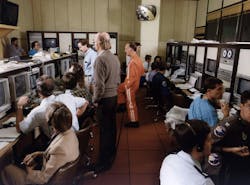Military researchers approach industry for autonomous aircraft flight testing using mobile instrumentation
ARLINGTON, Va. – U.S. military researchers are looking for new approaches to aircraft flight testing that would free designers from the constraints of traditional test ranges and enable autonomous testing on-demand.
Officials of the U.S. Defense Advanced research Projects Agency (DARPA) in Arlington, Va., issued a request for information (DARPA-SN-25-62) on Wednesday for the Rapid Operational Guided Unmanned Execution (ROGUE) project.
ROGUE seeks to develop an autonomous, networked system of mobile, reusable instrumentation that can collect critical test data through telemetry, optics, radar, targets, scoring, communications, and data backhaul for real time data transmission to dispersed test operators.
This project seeks breakthrough concepts that radically alter conventional flight testing by developing rapid and cost-effective ways to deploy mobile instrumentation to collect critical data on long-range flight tests.
Autonomous capabilities
Of interest are technologies that can remove dependencies on traditional test ranges and enable programs to test on demand, with an emphasis on autonomous capabilities. Responses may be used for future aircraft programs.
The U.S. military needs to solve the capacity issues of traditional major range and test facilities for long-range flight tests. Today's research relies on flight tests, but frequently must compete for limited test resources and access, which constrains learning and early fielding, DARPA researchers explain.
DARPA is interested in technologies that address data collection systems for long-range flight tests; communications and data transmission of real-time test data; and process changes for traditional test ranges.
Data collection for long-range flight tests may include telemetry, optics, radar, targets, and scoring, with an emphasis on autonomous operations.
Communications and data transmission
Communications and data transmission may include approaches to data prediction, real-time data analysis, model verification, test point optimization, digital modeling, and new analytical tools.
Process changes to traditional range procedures may include clearing of air space and identification of corridors that can reduce the need for notices to air missions (NOTAMs) and notices to mariners (NOTMARs) and other early indicators of imminent testing.
Proposed solutions should be able to scale to different missions and distances from 250 to 2,000 nautical miles.
DARPA researchers are looking for responses not only from defense companies, but also from individuals, universities, university-affiliated research centers, not-for-profit research institutions, and U.S. government-sponsored labs.
Companies interested should email unclassified responses no later than 7 May 2025 to [email protected]. Email questions or concerns to DARPA at [email protected]. More information is online at https://sam.gov/opp/0f766431693144b5894c50ec45a314ac/view.
About the Author
John Keller
Editor-in-Chief
John Keller is the Editor-in-Chief, Military & Aerospace Electronics Magazine--provides extensive coverage and analysis of enabling electronics and optoelectronic technologies in military, space and commercial aviation applications. John has been a member of the Military & Aerospace Electronics staff since 1989 and chief editor since 1995.

